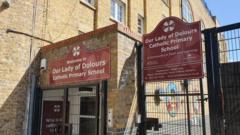Will Merging Primary Schools Solve the Decline in Student Numbers?

Understanding the Merger of Primary Schools in Westminster: Implications and Community Response
The landscape of education in Westminster is undergoing significant changes as five primary schools prepare to merge into two. This decision arises from a combination of declining student enrollment and mounting financial pressures. While the local authority aims to streamline resources and improve educational provisions, the affected communities have voiced their concerns. In this article, we will delve into the details of the merger, explore the reasons behind it, and discuss the community reactions surrounding this pivotal decision.
The Merger Breakdown: Schools Involved
The planned mergers involve three schools combining to form St John's Wood Primary School and a separate merger of Our Lady of Dolours into St Mary of the Angels Catholic Primary School. Below is a breakdown of the affected institutions:
- St John's Wood Primary School - Barrow Hill Junior School - Robinsfield Infant School - George Eliot Primary School
- St Mary of the Angels Catholic Primary School - Our Lady of Dolours
Context: Why the Merger? The Driving Forces
Several factors contribute to the need for merging schools in Westminster, which can be summarized as follows:
1. Declining Enrollment
All five schools involved have reported falling student numbers. Barrow Hill, for instance, is currently operating at 82% of its capacity, while George Eliot stands at 85%, and Robinsfield is at a mere 75%. Such low enrollment figures lead to reduced funding, as schools receive financial support based on the number of pupils they have.
2. Financial Pressures
With declining enrollment comes financial strain. The schools in question are facing significant deficits, projected at £550,000 for Our Lady of Dolours and £186,000 for St Mary of the Angels. These figures highlight the urgent need for restructuring to ensure the sustainability of educational services.
3. External Economic Influences
Factors such as falling birth rates and the high cost of housing in Westminster further exacerbate the situation. Families are moving out of the area, resulting in fewer children entering schools. The implications of this demographic shift are profound, impacting not just individual schools but the community's educational landscape as a whole.
Community Reactions: A Mixed Bag of Emotions
The proposed mergers have sparked a whirlwind of emotions among parents and community members. While some understand the financial realities prompting these changes, others are deeply concerned about the potential impact on the quality of education.
Opposition to the Merger
Resistance to the merger has been vocal, with one consultation revealing that 83% of parents opposed the changes. Many parents fear that merging schools will lead to overcrowded classrooms, particularly in the case of Our Lady of Dolours and St Mary of the Angels. A petition opposing the amalgamation raised concerns that the new structure could push the school to operate at 130% capacity, which could degrade the quality of learning.
Concerns Over Religious Identity
Another significant concern stems from the differing religious demographics of the schools involved. Only half of the pupils from Our Lady of Dolours practice Catholicism, raising fears that the merger could alter the religious character of St Mary of the Angels Catholic Primary School, which may impact community cohesion and values.
Governors’ Perspective: Navigating Change
The chairs of governors from the schools have acknowledged the concerns raised by parents. They are aware that the transition may bring about uncertainty and changes within the school communities. In a letter to parents, they addressed the reasons behind the merger, indicating that their decision was made with the intention of preserving educational opportunities in an increasingly challenging environment.
Formal Consultations and Next Steps
Following the decision to merge, the proposals have been submitted to Westminster City Council for formal consultations. This process is crucial as it allows for further discussion and consideration of community feedback. Parents and stakeholders are encouraged to participate actively in these consultations to express their opinions and suggest alternatives.
Alternative Solutions: What Are the Options?
Many parents have called for a deeper exploration of alternative solutions before proceeding with the mergers. Suggestions for alternative strategies include:
- Collaboration with nearby schools to share resources
- Implementing programs to attract more students
- Investigating community engagement initiatives to raise awareness about the schools' offerings
- Exploring financial support options from local businesses and organizations
Looking Ahead: What Does the Future Hold?
The future of primary education in Westminster hangs in the balance as the community grapples with the implications of these mergers. While the goal is to create a more sustainable educational framework, the journey ahead will require careful navigation of the challenges presented by the mergers. Parents and stakeholders must remain engaged in the process, advocating for their children's education while remaining open to the realities of the situation.
Conclusion: A Call for Community Engagement
As Westminster embarks on this transformative journey in its educational landscape, it is vital for parents, guardians, and community members to stay informed and involved. The decisions made today will have lasting impacts on the future of primary education in the area. By participating in consultations and voicing concerns, the community can play a critical role in shaping the educational environment for generations to come.
FAQs About the School Mergers in Westminster
What are the main reasons for the school mergers in Westminster?
The primary reasons include declining student enrollment, financial pressures due to reduced funding, and external economic factors such as falling birth rates and high housing costs.
How will the mergers affect class sizes and student experience?
There are concerns that the mergers could lead to overcrowded classrooms, particularly for schools operating above their capacity, which may affect the quality of learning and overall student experience.
What steps are being taken for community input on the merger proposals?
Formal consultations have been initiated, allowing parents and community members to express their opinions and concerns regarding the proposed mergers. Community engagement is encouraged to explore alternative solutions.
What can parents and guardians do to advocate for their schools?
Parents and guardians can participate in consultations, raise awareness about the issues, and propose alternative solutions to preserve and enhance educational opportunities for their children.
As the community navigates through this period of change, what steps do you believe are essential to ensure that educational standards remain high and that every child receives the best possible schooling experience? #WestminsterEducation #SchoolMergers #CommunityEngagement
Published: 2025-06-30 07:33:04 | Category: technology



